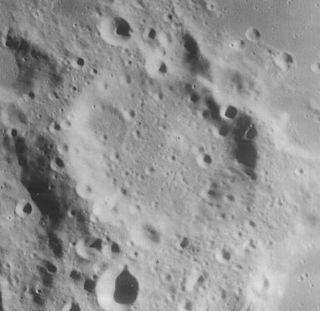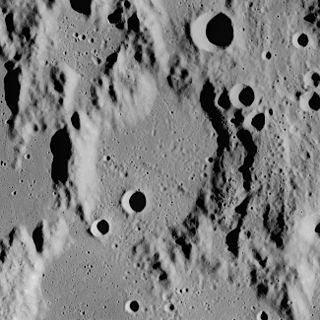
Capella is a lunar impact crater 49 km (30 mi) in diameter that lies to the north of the Mare Nectaris, in a rugged region with many small impact craters. It was named after Roman astronomer Martianus Capella. It intrudes slightly into the eastern rim of the crater Isidorus, a feature only slightly smaller in diameter.

Agatharchides is a lunar impact crater located at the southern edge of Oceanus Procellarum, in the region between the Mare Humorum and Mare Nubium. To the east-southeast is the crater Bullialdus, and to the south-southwest lies Loewy. It is named after the Greek geographer Agatharchides.

Hanno is a lunar impact crater that lies near the southeastern limb of the Moon, along the western edge of the Mare Australe. About a crater diameter to the southwest is the prominent crater Pontécoulant.

Appleton is a heavily eroded lunar impact crater that lies in the northern hemisphere on the far side of the Moon. To the northwest are the craters Von Neumann and Campbel. The smaller Golovin lies to the northeast, while further to the southwest is the Mare Moscoviense.

Armiński is a small lunar impact crater that is located on the far side of the Moon, to the northeast of the large walled basin Gagarin. To the northwest of Armiński is the crater Beijerinck, and to the southeast lies Cyrano.

Palisa is the remnant of a lunar impact crater that is located to the west of the walled plain Ptolemaeus. It lies to the north-northeast of the crater Davy, and is attached to the lava-flooded satellite crater Davy Y by a wide break in the southwest rim. The crater is named after the Austrian astronomer Johann Palisa.

Goddard is a lunar impact crater that is located along the eastern limb of the Moon, and so is visible from the edge from Earth. It is best viewed during favorable librations when the orientation of the Moon brings it further into sight. The crater is located in the Mare Marginis, to the northeast of the prominent crater Neper. Ibn Yunus, a crater remnant, is attached to the southeastern rim and is partly overlaid by Goddard. To the northeast is Al-Biruni.

Boole is a lunar impact crater that lies along the northwestern limb of the Moon, to the northwest of the crater Gerard. At this location it is viewed nearly from the side, and is very oblong in shape due to foreshortening. The crater formation is nearly circular, however, with a wide inner wall that has been worn and rounded due to subsequent impacts. It is named after George Boole.

Chamberlin is a lunar impact crater that is located on the far side of the Moon, just past the southeastern limb. It lies to the southeast of the crater Jeans, and Moulton is attached to the southeastern rim of Chamberlin. This crater is located in a part of the lunar surface that has undergone resurfacing of crater interiors, producing dark-hued crater floors.

Fontenelle is a lunar impact crater that is located along the northern edge of Mare Frigoris, in the northern part of the Moon. To the northeast is the remnant of the crater Birmingham. Due to its location, this crater appears oval in shape when observed from the Earth because of foreshortening.

Bellinsgauzen is a lunar impact crater that lies in the southern part of Moon, on the far side from the Earth. It is attached to the northern rim of the larger crater Berlage, and within a half crater diameter of Cabannes to the west. North of Bellinsgauzen is the crater Bhabha.

Gaudibert is a lunar impact crater that lies along the northeast edge of Mare Nectaris in the eastern part of the Moon's near side. Just to the east is the Montes Pyrenaeus mountain chain, and to the northeast beyond the mountains is the crater Gutenberg. Northwest of Gaudibert is the crater pair Isidorus and Capella.

T. Mayer, or Tobias Mayer, is a lunar impact crater that is located at the western end of the Montes Carpatus mountain range along the southern edge of Mare Imbrium. It was named after German astronomer Tobias Mayer. To the west is the Oceanus Procellarum, and to the south is Mare Insularum. The crater is located a couple of hundred kilometers to the northwest of the prominent crater Copernicus.

South is a large lunar impact crater that is located in the northwest part of the Moon. Most of the southern wall of this crater is joined to the Sinus Roris bay of the Oceanus Procellarum, with the southeast rim facing Mare Frigoris. Attached to the northwest of the formation is the larger walled plain Babbage. Just to the northeast is the crater Robinson, and farther to the northeast is another walled plain, J. Herschel.

Marinus is a lunar impact crater that is located near the southeastern limb of the Moon. At this location it is viewed at an oblique angle from the Earth, limiting the amount of detail that can be observed. It lies due north of the slightly larger and dark-floored crater Oken. To the east is the northern part of the Mare Australe.

Lorentz is a huge lunar impact crater that lies just beyond the northwest limb of the Moon, in a region that is brought into sight of the Earth during favorable librations. This formation is nearly as large as the Mare Nectaris on the near side of the Moon, although it has not been submerged by lava as have the lunar mare. Sections of the crater floor are, however, relatively level, particularly an arc along the western rim. But this last region is still marked by a number of tiny craterlets. The remainder of the interior is rough and irregular, and marked with a multitude of impacts.
Cailleux is a lunar impact crater that is attached to the southwest rim of the walled plain Poincaré. It is located in the southern part of the Moon's far side, and cannot be seen from the Earth. To the southeast of Cailleux is the crater Lyman, and nearly due westward is Prandtl.

Donner is a lunar impact crater on the far side of the Moon. It is located just to the northeast of the Mare Australe, behind the southeastern limb of the Moon. During favorable librations this part of the lunar surface can be brought into view of the Earth, but the site is viewed from the edge and so not much detail can be seen.

Fridman is the remains of a lunar impact crater on the far side of the Moon. It lies due south of the huge walled plain Hertzsprung, and is attached to the northeastern rim of the crater Ioffe.

Seidel is a worn lunar impact crater that lies to the east-northeast of the much larger crater Jules Verne. Farther to the east of Seidel is the western edge of Mare Ingenii, and to the northeast lies the crater O'Day.





















